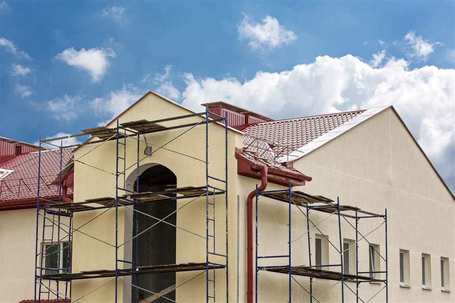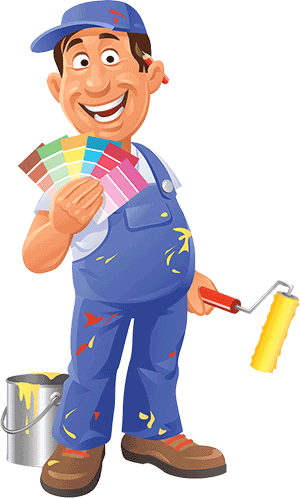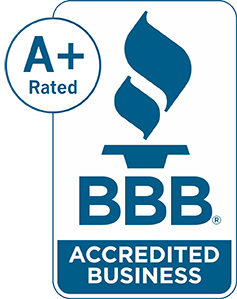A home’s exterior might be made up of a variety of materials; sometimes brick is used, or even wood. Quite commonly in newer residential buildings, the exterior is done with stucco. Wood and brick have rather obvious sources, but stucco seems to come in a variety of textures and colours; what materials are used in it’s creation, and why does it seem so ubiquitous? These are rhetorical questions for us, but nonetheless you’ll find the answers below.
In essence, stucco is a mix between aggregates, a binder and water. Aggregates is fancy term for grained particulate like sand and gravel, and binders, also used in paint, are whatever substance is used to hold the aggregates and water together to form a manipulable substance. Traditional stucco used lime as the binder for sand and water; modern stucco uses Portland cement, which itself is a mix of limestone and clay that hardens when reacting with water.
Stucco is commonly used because it is quite hard, though the modern stuff can be a bit brittle. The cost of stucco is quite low compared to, say, a brick facade, and the substance can be easily manipulated to add particular colours and textures. Stucco can be applied over many less attractive building materials, like adobe, so it’s a good way of sprucing up an otherwise spartan looking home.
The material does come with a few disadvantages, however. Stucco is porous, so without a protective coating it can become vulnerable to water damage. The material is applied in several layers, so deep damage can take time and effort to repair; it’s best to keep an eye on a home’s exterior to quickly repair any cracks that could develop. Some stucco uses acrylic polymers to add water-resistance. Acrylic polymers don’t breathe, so water can’t seep through, but any water that goes through the cracks may cause raising and damage. Water damage to the house is mitigated by a house wrap that’s applied before the layers of stucco, but persistent leakage can still cause problems. Additionally, in a climate where freezing occurs, water trapped between the stucco and home can freeze, expanding and causing cracks.
Elastomeric coating is one solution to the stucco cracking problem. This type of acrylic paint is incredibly thick compared to other acrylics, which allows it to stretch. The paint is also waterproof, providing an extra layer of protection against the elements. The elasticity of the paint is extremely valuable; it can bend and stretch without breaking, which eliminates cracking.
Stucco can be used inside as well; traditional stucco was frequently used inside basilicas and other ecclesiastical buildings to create stunning, textured looks. Stucco painters can thus redo your exterior and offer the best interior painting services. While painting stucco is an extremely viable option, if you’re constructing your home and you know what colour you want your exterior to be, opt instead to have a coloured stucco applied as the exterior layer; this will save you money, as it’s longer lasting than a coat of paint.
In essence, stucco is a mix between aggregates, a binder and water. Aggregates is fancy term for grained particulate like sand and gravel, and binders, also used in paint, are whatever substance is used to hold the aggregates and water together to form a manipulable substance. Traditional stucco used lime as the binder for sand and water; modern stucco uses Portland cement, which itself is a mix of limestone and clay that hardens when reacting with water.
Stucco is commonly used because it is quite hard, though the modern stuff can be a bit brittle. The cost of stucco is quite low compared to, say, a brick facade, and the substance can be easily manipulated to add particular colours and textures. Stucco can be applied over many less attractive building materials, like adobe, so it’s a good way of sprucing up an otherwise spartan looking home.
The material does come with a few disadvantages, however. Stucco is porous, so without a protective coating it can become vulnerable to water damage. The material is applied in several layers, so deep damage can take time and effort to repair; it’s best to keep an eye on a home’s exterior to quickly repair any cracks that could develop. Some stucco uses acrylic polymers to add water-resistance. Acrylic polymers don’t breathe, so water can’t seep through, but any water that goes through the cracks may cause raising and damage. Water damage to the house is mitigated by a house wrap that’s applied before the layers of stucco, but persistent leakage can still cause problems. Additionally, in a climate where freezing occurs, water trapped between the stucco and home can freeze, expanding and causing cracks.
Elastomeric coating is one solution to the stucco cracking problem. This type of acrylic paint is incredibly thick compared to other acrylics, which allows it to stretch. The paint is also waterproof, providing an extra layer of protection against the elements. The elasticity of the paint is extremely valuable; it can bend and stretch without breaking, which eliminates cracking.
Stucco can be used inside as well; traditional stucco was frequently used inside basilicas and other ecclesiastical buildings to create stunning, textured looks. Stucco painters can thus redo your exterior and offer the best interior painting services. While painting stucco is an extremely viable option, if you’re constructing your home and you know what colour you want your exterior to be, opt instead to have a coloured stucco applied as the exterior layer; this will save you money, as it’s longer lasting than a coat of paint.



